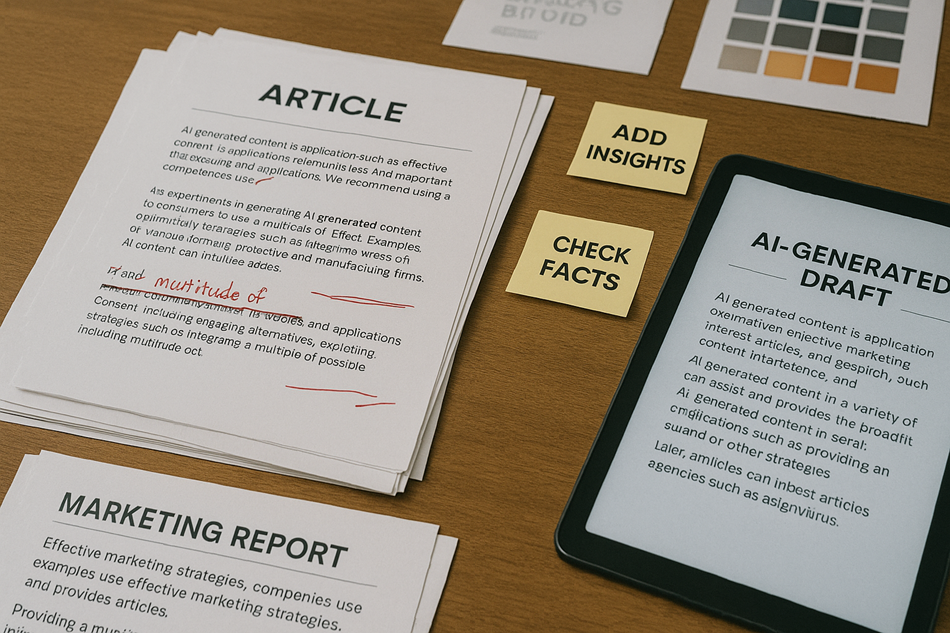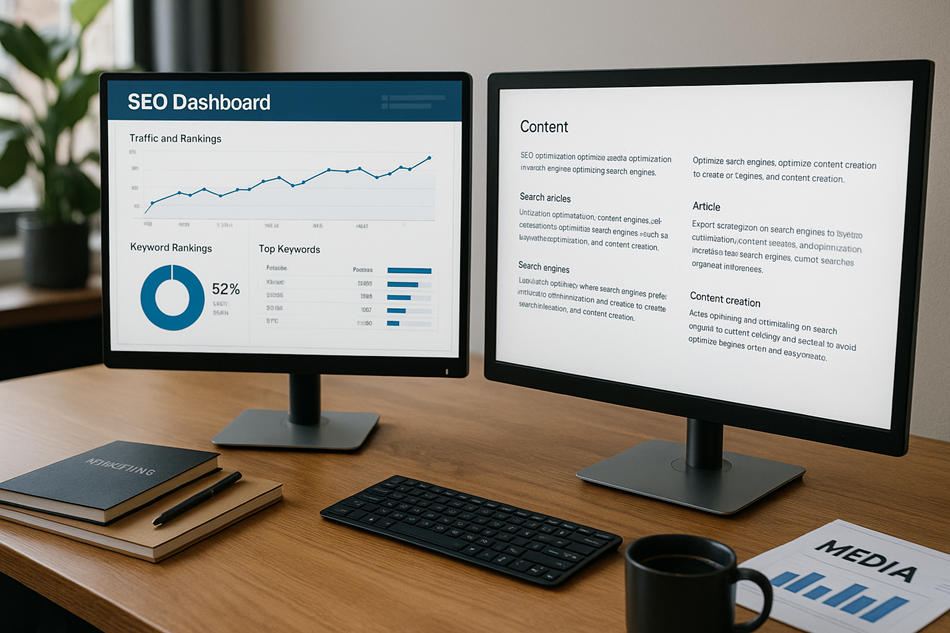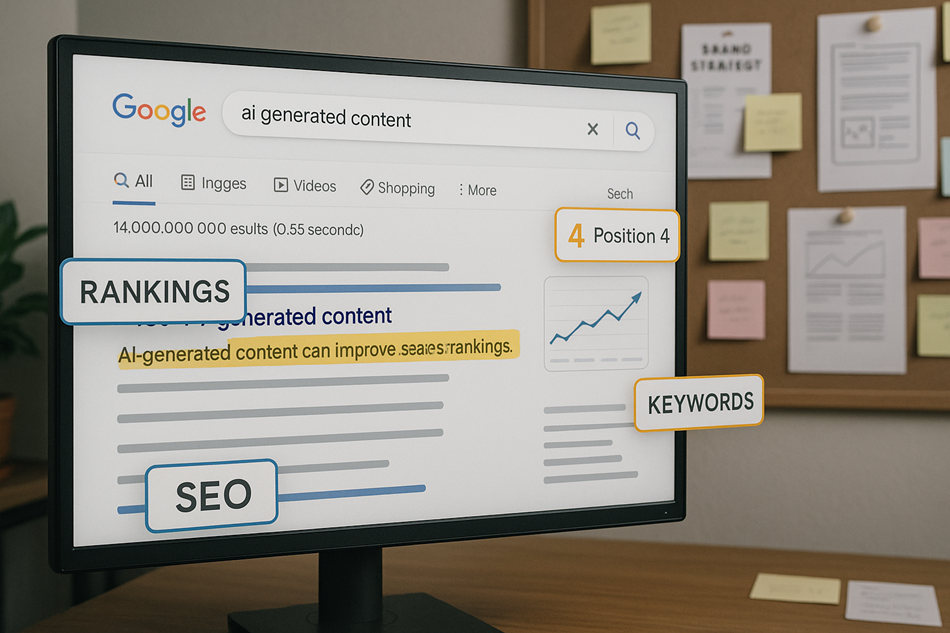AI tools have made it possible to create content at an stupendous pace.
What used to take hours of drafting and editing can now appear in seconds with a single prompt.
But speed and scale don’t always translate to quality, and that’s where the debate begins.
This article delves into whether AI-generated content is good for SEO, the risks involved, and how to use it wisely.
Key Takeaways
- Google doesn’t punish AI content for being AI; what it punishes is content that’s shallow, unhelpful, or misleading.
- AI works best when paired with human oversight to add accuracy, authority, and originality.
- The benefits of AI include faster production, lower costs, and keyword optimization, but the risks include poor quality, penalties, and lack of credibility.
- Safe use of AI means fact-checking, tailoring content to search intent, and ensuring it meets EEAT standards.
- AI is ideal for meta descriptions, product descriptions, and outlines, but unsuitable for expert, medical, or opinion-driven content.
- The future of SEO will favor hybrid models where AI handles routine tasks and humans provide depth, insight, and authentic voice.
What Counts as AI Generated Content?
AI-generated content can mean different things depending on how it’s produced and used.
It’s not only about articles written by a machine, but also about the many ways AI supports or shapes the writing process.
Understanding these categories helps clarify what Google may evaluate when ranking content.
Fully AI-written content
This refers to text created entirely by an AI tool without human input beyond the initial prompt. Examples include:
- Blog posts written start to finish by AI.
- Product descriptions automatically generated in bulk.
- News summaries created directly from data feeds.
The advantage here is speed and scalability, but the drawback is the lack of originality, nuance, and authority.
AI-assisted content
This is when AI contributes to part of the process but doesn’t handle everything. Writers may use AI to:
- Generate outlines for articles.
- Suggest keyword variations.
- Provide first drafts that humans later refine.
AI-assisted content is often more reliable for SEO because it still incorporates human judgment and oversight.
AI-augmented content
In this case, AI enhances or supplements human writing rather than replacing it. For instance, a human may write an article, while AI suggests on-page SEO improvements or helps optimize headlines and meta descriptions.
This approach keeps the human voice intact while still benefiting from AI’s data-driven insights.
Why this distinction matters
Not all AI content is treated the same by search engines. Google is less concerned with how content is produced and more with the value it delivers.
The difference lies in whether the final output reads as helpful, original, and credible… or as mass-produced filler.
Google’s Take on AI Content
Google’s view on AI-generated content has shifted over time. Early on, the company flagged automatically created text as spam because it often lacked originality and value.
But with AI tools becoming mainstream, Google has had to refine its approach, focusing more on quality than on the method of creation.
How Google treated AI content in the past
For years, Google’s Webmaster Guidelines warned against “automatically generated” content. The concern was that websites were publishing pages stuffed with keywords or scraped summaries that added no real value to users.
Such content often ranked poorly and risked penalties.
The introduction of helpful content updates
In recent years, Google launched its Helpful Content Updates to prioritize content written for people rather than for search engines. This was a turning point.
Instead of banning AI outright, Google began stressing the importance of usefulness, clarity, and depth. If AI-generated text doesn’t meet these standards, it’s likely to be downgraded.
The role of EEAT
Google’s quality guidelines now emphasize EEAT: Experience, Expertise, Authoritativeness, and Trustworthiness.
AI content struggles in areas like experience and expertise because it can’t draw from personal knowledge or lived reality. Human input is therefore essential to meet these criteria.
What matters most to Google
At its core, Google doesn’t punish AI for being AI. It penalizes content that is shallow, unhelpful, or misleading.
On the other hand, if a piece of content created with AI provides genuine insight, is factually accurate, and adds value, it can perform just as well as human-written material.
Benefits of AI Generated Content for SEO
AI-generated content isn’t automatically harmful to rankings. In fact, when used thoughtfully, it can support an SEO strategy by saving time, improving consistency, and helping writers focus on higher-value work.
The key lies in how it’s applied.
Speed and scalability
AI allows businesses to create content at a pace that would be impossible for most writing teams alone.
For companies in industries where fresh content is essential, including news, e-commerce, or technology, AI can provide quick drafts or bulk product descriptions that keep websites active and visible.
Cost efficiency
Hiring large teams of writers or agencies can quickly add up. AI offers a lower-cost alternative for tasks like generating outlines, filling in repetitive content, or creating variations of ad copy.
While it shouldn’t replace skilled writers, it can reduce the need for repetitive manual work.
Data-driven optimization
Many AI tools also analyze. They can highlight trending keywords, suggest related search terms, or structure articles in a way that matches common search intent.
This data-driven support can help content align more closely with what users are searching for, giving it a better chance to rank.
Support for human writers
Writers often face creative blocks or spend too much time on repetitive drafting. AI helps break that cycle by providing a starting point.
A rough draft, a few headline options, or even suggested subtopics can free writers to focus on refining the message, adding depth, and ensuring the piece reflects a brand’s unique voice.
The Risks of AI Generated Content for SEO
AI-generated content has clear advantages, but it also carries risks that can undermine a website’s visibility and credibility if left unchecked.
Understanding these pitfalls is essential for using AI responsibly in SEO.
Quality concerns
AI tends to produce text that is grammatically correct but often generic. It may lack original ideas, nuanced arguments, or fresh perspectives.
Over time, publishing too much shallow content can weaken a site’s authority and reduce its ability to build trust with readers.
Google penalties and detection
Google has made it clear that content designed to manipulate rankings, regardless of how it’s created, can be penalized. Large volumes of low-quality AI text may trigger algorithm updates that filter out unhelpful pages.
While AI detectors are imperfect, search engines are improving their ability to recognize repetitive, machine-like writing patterns.
Lack of authority and expertise
Readers and Google look for signs of credibility. AI cannot share first-hand experiences, professional insights, or unique case studies.
In industries like health, law, or finance, this absence of authority can harm both rankings and audience trust.
User experience issues
Even when AI-generated text is factually correct, it can still feel off to readers. Awkward phrasing, repetitive structures, or a tone that doesn’t match the brand can discourage visitors from staying on the page.
A poor user experience reduces engagement metrics such as dwell time, which in turn affects SEO performance.
How to Use AI Generated Content Safely for SEO

AI can be a helpful part of an SEO strategy, but only if used carefully. The key is to treat AI as an assistant, not a replacement.
With the right safeguards, you can enjoy the efficiency of AI without risking penalties or losing credibility.
Always add human oversight
AI is good at producing drafts, but it cannot judge accuracy or tone. Every piece of AI content should be reviewed by a human editor who can fact-check, refine the flow, and adjust for brand voice.
This layer of oversight is what separates helpful content from filler.
Blend AI with EEAT principles
To meet Google’s EEAT standards, add elements that AI cannot provide. This includes personal experiences, professional expertise, author attribution, and references to credible sources.
Even small touches, like a case example or a direct quote, can make the difference between generic text and trusted authority.
Optimize for search intent, not just keywords
AI tools can generate keyword lists, but keywords alone don’t guarantee relevance. Humans need to ensure that the content addresses the real questions behind a search.
This might mean restructuring an article to focus more on user pain points or expanding sections where AI only scratched the surface.
Focus on content depth and value
Surface-level answers rarely rank for competitive queries. After AI creates a draft, expand it with insights, data, multimedia, or examples.
This added value signals to both readers and search engines that your content is genuinely useful.
Real-World Examples and Case Studies
AI-generated content has already left a noticeable mark on SEO. Some businesses have seen strong results by combining AI with editorial oversight, while others have suffered penalties for relying too heavily on automated writing.
These examples highlight the difference execution makes.
Sites that succeeded with AI assistance
Some media companies and marketing agencies use AI to handle first drafts or routine content, such as product descriptions, FAQs, and news summaries.
Human editors then refine the drafts, inject expert commentary, and shape the narrative for readers. This mix of speed and human input often leads to:
- Faster publishing cycles without sacrificing quality.
- Higher search rankings for topics where freshness matters.
- Consistent traffic growth from long-tail keywords covered in bulk.
This approach works because AI does the repetitive groundwork while humans ensure accuracy, creativity, and authority.
Sites that got penalized
On the other side, there are cases where websites published thousands of AI-written pages without review. Many of these pages were stuffed with keywords, thin on value, and repetitive in structure.
When Google rolled out its Helpful Content Updates, these sites saw sharp drops in rankings and traffic.
The lesson is clear: mass-producing AI text without oversight may offer short-term visibility but carries long-term risks.
Google’s algorithms reward content that helps people, not content created to game search results.
Best Practices Checklist for AI Content and SEO
Before publishing AI-assisted content, it’s wise to run through a quick checklist.
This helps catch weak points and ensures the final piece stands a chance of ranking well.
Does the piece provide genuine value?
Ask if the content goes beyond surface-level answers. Readers should leave with a clear takeaway they couldn’t get from a dozen other articles.
Is it fact-checked and accurate?
AI can sometimes misstate facts or generate outdated information. Every claim, stat, or example should be reviewed for accuracy.
Is there a clear human editorial layer?
Content performs better when a human voice is present. Edits for flow, tone, and brand consistency are non-negotiable.
Does it meet EEAT standards?
Check for signs of expertise and authority, such as author bylines, references, or first-hand examples. These are strong signals to Google.
Does it sound natural and align with brand tone?
Awkward phrasing or robotic repetition should be smoothed out. Readers should feel like they’re hearing from a real person, not a script.
Is it tailored to search intent?
Go beyond keywords. Does the piece answer the underlying question the user had when they typed their search? If not, revise before publishing.
Where AI Content Makes the Most Sense

AI is not a one-size-fits-all solution. It shines in some areas of content creation but falls flat in others.
Knowing when to use it and, for that matter, when to avoid it, can make the difference between boosting SEO and damaging credibility.
Good use cases
AI can be a powerful helper in repetitive, data-driven, or time-sensitive content needs. Some of the most effective applications include:
- Meta descriptions and ad copy variations: Short, punchy lines that benefit from quick generation and multiple options.
- FAQs and knowledge base entries: Structured, predictable formats that AI can handle efficiently, with human review for accuracy.
- Content outlines and brainstorming: Generating lists of subtopics, headlines, or structural ideas to speed up planning.
- Product descriptions for large catalogs: Writing consistent and keyword-rich descriptions at scale, provided humans refine tone and details.
These uses reduce the burden on writers while keeping quality standards intact.
Bad use cases
Some content types require depth, lived experience, or strong personal voice. Relying on AI alone in these areas can hurt SEO and erode trust:
- Medical, legal, or financial advice: These fields demand professional authority and accountability that AI cannot provide.
- Thought leadership or opinion pieces: Audiences expect unique perspectives, not generic insights.
- Investigative or research-heavy articles: AI lacks the ability to conduct interviews, gather original data, or uncover new angles.
- Niche expert content: When the subject demands specialized knowledge, generic AI writing won’t measure up.
Using AI in these cases risks not only rankings but also credibility with your audience.
The Future of AI Content and SEO
AI content will continue to play a role in digital marketing, but its impact on SEO will depend on how both businesses and search engines evolve.
The future points toward balance: using AI for efficiency while doubling down on human originality and authority.
Smarter content detection
Search engines are becoming more sophisticated at spotting patterns typical of AI text. Over time, this will make it harder to rely on machine-generated content without meaningful human oversight.
Google will continue rewarding depth, context, and originality, qualities that AI struggles to replicate on its own.
Growth of hybrid models
The winning strategy for most brands will be hybrid content creation, where AI handles the repetitive groundwork and humans refine, expand, and personalize.
This approach balances speed with credibility, allowing teams to publish more without sacrificing quality.
Greater emphasis on unique perspectives
As the web fills with AI-generated articles, unique human perspectives will become even more valuable. Search engines will likely prioritize lived experience, expert commentary, and original data over recycled summaries.
This trend benefits writers and brands that can share authentic insights.
Shifts in search behavior
As AI chatbots and voice assistants become more common, search queries themselves may change. Instead of simple keyword phrases, people will use natural, conversational questions.
Content that directly answers these questions with clarity and authority will stand out in future rankings.
How Trelexa Helps You Navigate AI Content for SEO
AI can give you speed, but it’s the human touch that keeps your content ranking and resonating.
At Trelexa, we bring both together using AI where it makes sense while shaping every piece with editorial care and strategic SEO expertise. The result is content that works for search engines and speaks to people.
Need help or have questions? Get in touch with us.
Final Thoughts
AI-generated content can help with SEO, but it’s not a shortcut to guaranteed rankings.
Success depends on how it’s used, how much value it delivers, and how well it balances automation with human oversight.
The future belongs to brands that treat AI as a tool rather than a replacement; those willing to pair efficiency with expertise, and speed with substance.

